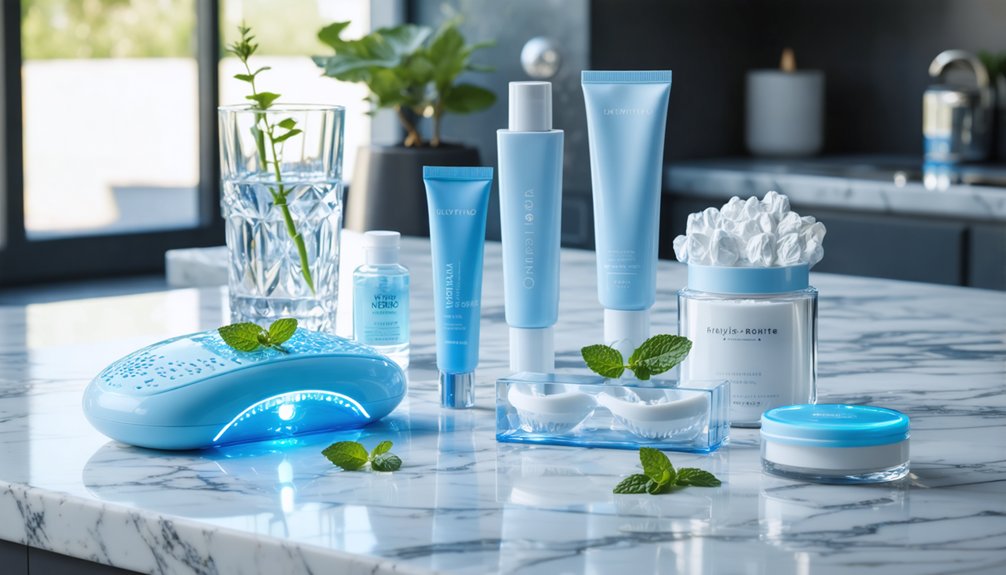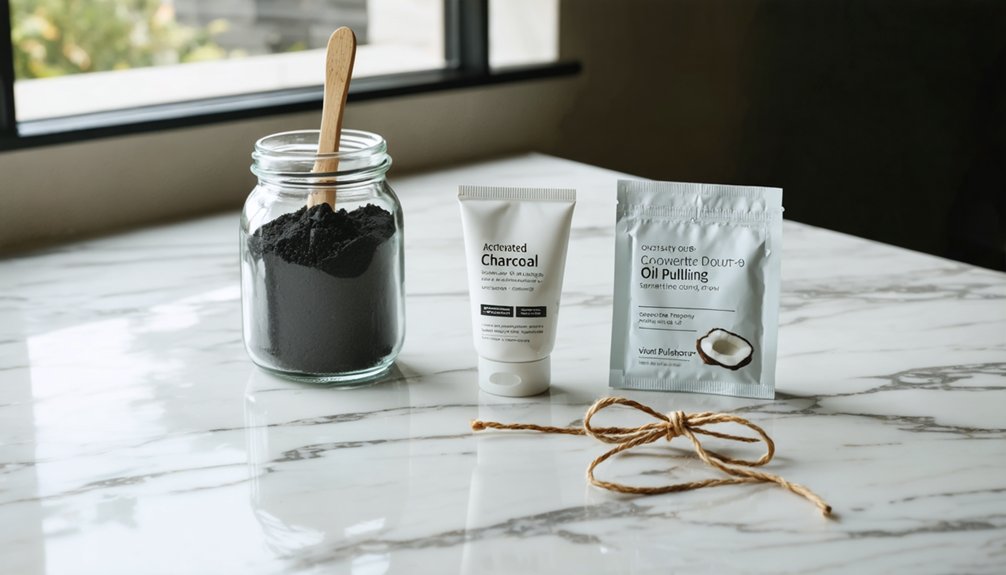You can brighten your smile without the pain using several sensitivity-friendly whitening methods. Custom-fitted trays with low-concentration gels offer precise application, while professional treatments incorporate desensitizing agents for comfort. Gentle whitening strips and pens provide convenient at-home options, and desensitizing toothpaste with whitening agents offers daily maintenance. Even natural solutions like baking soda can effectively remove surface stains. Learn these proven techniques to achieve your desired results while protecting your sensitive teeth.
Key Takeaways
- Custom-fitted dental trays with low-concentration whitening gels provide even coverage while minimizing gum irritation and tooth sensitivity.
- Professional in-office treatments incorporating desensitizing agents like potassium nitrate and fluoride offer pain-free whitening results.
- Gentle whitening strips and pens contain mild formulations that gradually brighten teeth without causing discomfort.
- Desensitizing toothpaste with whitening agents helps reduce tooth sensitivity while providing gradual brightening effects.
- Natural baking soda methods offer a gentle, non-irritating approach to removing surface stains without harsh chemicals.
Custom-Fitted Trays With Low-Concentration Gels
While many teeth whitening options can cause discomfort, custom-fitted trays with low-concentration gels offer a gentle yet effective solution for achieving a brighter smile.
These trays are precisely molded to your unique dental anatomy, ensuring even gel distribution and maximum coverage – even for uneven or crooked teeth.
You’ll experience minimal sensitivity because the custom trays prevent gel from seeping onto your gums, while lower gel concentrations help protect your enamel.
Under professional supervision, you can adjust wear time and gel concentration based on your comfort level. Professional guidance ensures optimal safety and effectiveness throughout your whitening treatment.
The trays fit seamlessly into your daily routine, allowing you to whiten at home while maintaining control over the process. Your dentist will provide specific usage instructions to optimize your whitening results.
Best of all, you’ll achieve consistent, long-lasting results without the intense sensitivity often associated with more aggressive whitening methods.
Professional In-Office Treatment With Desensitizers
Although in-office teeth whitening traditionally caused considerable discomfort, modern professional treatments now incorporate powerful desensitizing agents that make the process virtually pain-free.
Your dentist can apply specialized desensitizing agents before, during, and after your whitening treatment to block nerve signals and protect your teeth.
These in-office protocols typically combine potassium nitrate, fluoride, and calcium phosphate compounds that work together to prevent sensitivity.
Modern dental treatments blend key compounds like potassium nitrate, fluoride, and calcium phosphate to shield teeth from whitening sensitivity.
The desensitizing agents begin working within minutes, considerably reducing discomfort during high-concentration peroxide treatments.
High-fluoride varnishes can be applied to seal dentinal tubules and promote rapid remineralization of the teeth.
Studies show that sensitivity peaks immediately after treatment but significantly decreases within 24 hours of completion.
Your dentist will carefully time the application of these protective compounds to maximize both whitening results and comfort.
While no solution completely eliminates sensitivity for everyone, professional desensitizing treatments dramatically improve the comfort of in-office whitening, allowing you to achieve bright results with minimal discomfort.
Gentle Whitening Strips and Pens
For those seeking at-home whitening solutions with minimal sensitivity, gentle whitening strips and pens offer effective alternatives to professional treatments. Sensodyne users can maintain their whitening regimen with sensitive tooth-friendly toothpaste for daily care.
You’ll find several key whitening pen benefits, including precise application and portable convenience, while strips provide even coverage for thorough results. Consistent nightly use of products like Optic White Overnight can show visible improvements within a week.
When choosing sensitivity management options, consider these essential features:
- Natural formulas with coconut oil and Dead Sea salt offer microbiome-friendly whitening
- Carbamide peroxide-based products provide gentler results than hydrogen peroxide
- Targeted application pens let you control gel amounts for specific stains
- Non-peroxide strips work safely on veneers and crowns
Both options deliver gradual results while protecting sensitive teeth.
You’ll appreciate that these products often include soothing ingredients like lavender oil and come in pleasant flavors, making your whitening experience more comfortable and enjoyable.
Desensitizing Toothpaste With Whitening Agents
Desensitizing toothpastes with whitening agents offer a dual-action solution that both brightens your smile and protects sensitive teeth.
These specialized formulas contain active ingredients like potassium nitrate, which calms nerve sensitivity, and CPP-ACP, which strengthens your enamel through remineralization.
You’ll find these toothpastes particularly effective when used before, during, and after professional whitening treatments.
Research shows they noticeably reduce tooth sensitivity, especially with 22% carbamide peroxide home treatments or single-session 35% hydrogen peroxide procedures.
For best results, brush three times daily for at least four weeks.
The combination of desensitizing agents with gentle whitening components helps you achieve a brighter smile without discomfort.
Modern desensitizing agents work in harmony with whitening elements to enhance your smile’s brightness while keeping sensitivity at bay.
While the whitening effects are mild compared to in-office treatments, you’ll benefit from consistent protection against sensitivity while gradually improving your tooth color.
Clinical studies demonstrate that tricalcium phosphate toothpastes significantly reduce tooth sensitivity compared to non-active ingredient formulas.
Natural Baking Soda and Peroxide Methods
While many people seek professional whitening treatments, natural methods using baking soda offer a gentle, cost-effective alternative for removing surface stains.
You’ll find several baking soda benefits, including its ability to neutralize mouth acids and break down plaque while whitening. The antibacterial properties help prevent tooth decay and reduce harmful bacteria in the mouth.
Similar to removing stains on clothing, baking soda can effectively lift discoloration from your teeth through gentle buffing action.
For safe and effective results, consider these essential steps:
- Mix baking soda with water to create a smooth paste, avoiding gritty textures.
- Brush gently with a soft-bristled toothbrush no more than once every two weeks.
- Rinse thoroughly until all residue is gone.
- Consider combining with peroxide for enhanced results, but follow peroxide precautions.
Remember to maintain gentle pressure when brushing, as excessive force can damage your enamel.
While hydrogen peroxide delivers deeper whitening effects, baking soda’s mild abrasive action effectively removes surface stains without harsh chemicals.
Frequently Asked Questions
How Long Should I Wait Between Whitening Treatments to Avoid Sensitivity?
You’ll need to wait at least six months between professional treatments for proper sensitivity management. For at-home whitening trays, reduce your treatment frequency to once weekly instead of twice.
Can Certain Medications Affect the Success of Teeth Whitening Treatments?
Yes, your daily companions (medications) can greatly impact treatment effectiveness. Some create deep internal stains that resist whitening, while others cause surface discoloration that’s more responsive to treatment.
Does Teeth Whitening Work on Dental Crowns or Veneers?
No, you can’t whiten dental crowns or veneers since they’re made of non-porous materials. Crown whitening isn’t possible, but proper veneer maintenance through professional cleaning helps keep their original shade looking fresh.
At What Age Is It Safe to Start Teeth Whitening?
While you’re enthusiastic to brighten your smile, you’ll need to wait until age 14-15 for safe teeth whitening practices. Your dentist should evaluate your dental maturity before approving any whitening treatments.
Will Smoking Impact the Effectiveness of Teeth Whitening Treatments?
Yes, smoking greatly reduces your whitening results and causes faster staining afterward. You’ll need more frequent treatments to maintain whiteness, and smoking effects can quickly reverse any improvements you achieve.
References
- https://www.cincytoothdoc.com/teeth-whitening-for-sensitive-teeth-safe-options-that-work/
- https://www.sensodyne.com/en-us/oral-health-tips/whitening-sensitive-teeth/what-to-know/
- https://supremiadentistry.com/the-5-best-ways-to-whiten-sensitive-teeth/
- https://myvallejodentist.com/2024/06/27/how-to-reduce-tooth-sensitivity-during-whitening-treatment/
- http://www.goochlanddentistry.com/whats-the-best-teeth-whitener-for-sensitive-teeth/
- https://www.riverwalkdentalcarect.com/post/how-to-reduce-sensitivity-after-teeth-whitening-top-tips-advice
- https://pmc.ncbi.nlm.nih.gov/articles/PMC4058574/
- https://www.mayoclinic.org/healthy-lifestyle/adult-health/expert-answers/sensitive-teeth/faq-20057854
- https://www.nextdentallab.com/why-custom-whitening-trays-are-the-gold-standard-for-your-patients/
- https://vdcak.com/blog/cosmetic-dentistry/custom-whitening-trays/



